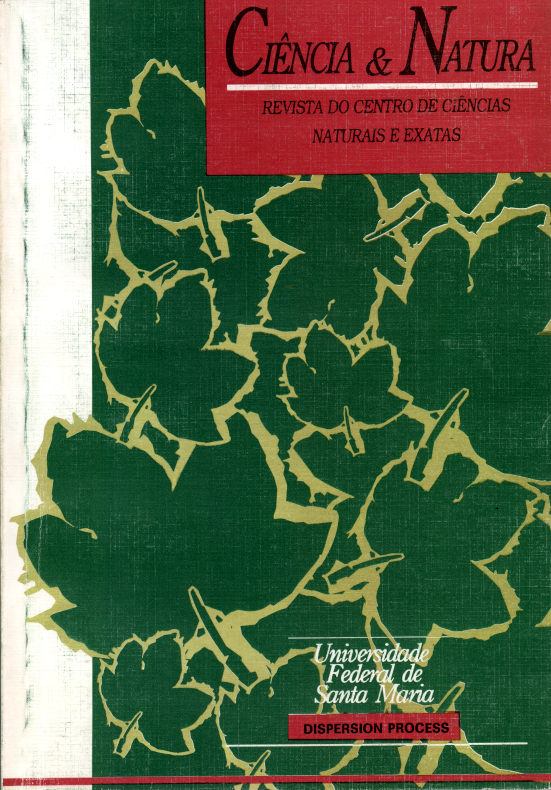Decaimento da turbulência convectiva: uma estimativa do coeficiente de difusão turbulento na camada residual
DOI:
https://doi.org/10.5902/2179460X36901Resumo
Neste trabalho é apresentado um modelo que descreve o decaimento da energia cinética turbulenta convectiva e estima o coeficiente de difusão turbulento na Camada Residual. A equação dinâmica para a função espectro de energia é obtida da forma clássica a partir da equação de Navier-Stokes. São considerados os termos que descrevem a transferência inercial de energia, a produção ou destruição de energia por efeito térmico e a dissipação molecular. A transferência inercial de energia é parametrizada a partir da teoria estatística de Taylor. Emprega-se a teoria de Heisenberg baseada no conceito de uma viscosidade cinemática turbulenta para descrever a transferência inercial de energia dos grandes para os pequenos turbilhões. O termo que descreve a produção ou destruição de energia cinética por efeito térmico é parametrizado a partir da teoria de similaridade convectiva considerando-se a hipótese de Pao, a qual supõe que a energia é extraída do fluxo médio de forma contínua, o que permite não explicitar uma escala de tempo característica. Pelo fato das equações dinâmicas que descrevem o fluxo turbulento serem válidas somente no espaço tridimensional, foi obtido um espectro 3-D da Camada Convectiva a partir de um modelo proposto por Kristensen, e do modelo para os espectros unidimensionais obtido por Degrazia. O coeficiente de difusão turbulento é determinado a partir da teoria estatística de Taylor e teoria de similaridade convectiva. Os resultados obtidos neste trabalho são comparados com o modelo de LES.Downloads
Referências
Batchelor, G.K.: 1949, 'The role of big eddies In homogeneous turbulence', Proc. Roy. Soc. A195, 513-532
Batchelor, O.K.: 1959, 'The theory of homogeneous turbulence', monografia de Mecânica e Matemática Aplicada, Cambridge University Press, 197 pp
Degrazia G.A. e Moraes O.L.L.: 1992, 'A model for eddy diffusivity in a stable boundary layer'. Boundary-Layer Meteorol, 58, 205-214
Degrazia G., Anfossi D., Moraes O.L.L. e Trini Castelli S.: 1997, ‘A model for the turbulence parameterization in the residual layer’. AIR POLLUTION V, H. Power, T. Tirabassi e C.A. Brebbia editors, 101-107
Degrazia G.A., Anfossi D., Fraga De Campos Velho H. e Ferrero E.: 1998 ‘A Lagrangian decorrelation time scale for non-homogeneous turbulence’ Boundary-Layer Meteorol., 86, 525-534
Degrazia, G.A. and Anfossi, D.: 1998, ‘Estimation of the Kolmogorov constant Co from classical statistical diffusion theory’, Atmos. Environm., 32, 3611-3614
Hanna S.R: 1981 ‘Lagrangian and Eulerian time-scale i the daytime boundary layer’. J. AppI. Meteor., 20, 242-249
Hinze J.O.: 1975, ‘Turbulence’, Mc Graw Hill, 790 pp
Kaimal J.C. Wyngaard J.C., Izumi Y. e Cote’ O.R.: 1972, ‘Spectral characteristics of surface layer turbulence’ Quart. J.C. Roy. Meteorol. Soc., 98, 563-589
Kim, J. e Mahrt L.: 1992, ‘Simple formulation of turbulent mixing in the stable free atmosphere and nocturnal boundary layer’ Tellus 44A, 381-394
Kristensen, L., Lenschow, D., Kirkegaard, P. e Courtney, M.: 1989, ‘The Spectral Velocity Tensor For Homogeneous Boundary-Layer Turbulence’, Boundary-Layer Meteorol. 47,149-193
Moeng, C. H. e Sullivan P. P.: 1994, ‘A Comparison of Shear- and Buoyancy-Driven Planetary Boundary Layer Flows’, J. Atmos. Sci., 51, 999-1022
Nieuwstadt, F.T.M. e Brost R.A.: 1986, ‘The decay of convective turbulence’, J. Atmos. Sci. 43, 532-546
Pao, Y.H.: 1965, ‘Structure of Turbulent Velocity and Scalar Fields at Large Wavenumbers’, The Physics of Fluids, 8, 1063-1075
Stanisic, M.M.: 1988, ‘The mathematical theory of turbulence’, Berlin Nova York,501pp
Stull, L.B.: 1988, ‘An introduction to Boundary Layer Meteorology’, Kluwer Academic Publishers, Boston, 666 pp.
Downloads
Publicado
Como Citar
Edição
Seção
Licença
Para acessar a DECLARAÇÃO DE ORIGINALIDADE E EXCLUSIVIDADE E CESSÃO DE DIREITOS AUTORAIS clique aqui.
Diretrizes Éticas para Publicação de Revistas
A revista Ciência e Natura está empenhada em garantir a ética na publicação e na qualidade dos artigos.
A conformidade com padrões de comportamento ético é, portanto, esperada de todas as partes envolvidas: Autores, Editores e Revisores.
Em particular,
Autores: Os Autores devem apresentar uma discussão objetiva sobre a importância do trabalho de pesquisa, bem como detalhes e referências suficientes para permitir que outros reproduzam as experiências. Declarações fraudulentas ou intencionalmente incorretas constituem comportamento antiético e são inaceitáveis. Artigos de Revisão também devem ser objetivos, abrangentes e relatos precisos do estado da arte. Os Autores devem assegurar que seu trabalho é uma obra totalmente original, e se o trabalho e / ou palavras de outros têm sido utilizadas, isso tem sido devidamente reconhecido. O plágio em todas as suas formas constitui um comportamento publicitário não ético e é inaceitável. Submeter o mesmo manuscrito a mais de um jornal simultaneamente constitui um comportamento publicitário não ético e é inaceitável. Os Autores não devem submeter artigos que descrevam essencialmente a mesma pesquisa a mais de uma revista. O Autor correspondente deve garantir que haja um consenso total de todos os Co-autores na aprovação da versão final do artigo e sua submissão para publicação.
Editores: Os Editores devem avaliar manuscritos exclusivamente com base no seu mérito acadêmico. Um Editor não deve usar informações não publicadas na própria pesquisa do Editor sem o consentimento expresso por escrito do Autor. Os Editores devem tomar medidas de resposta razoável quando tiverem sido apresentadas queixas éticas relativas a um manuscrito submetido ou publicado.
Revisores: Todos os manuscritos recebidos para revisão devem ser tratados como documentos confidenciais. As informações ou ideias privilegiadas obtidas através da análise por pares devem ser mantidas confidenciais e não utilizadas para vantagens pessoais. As revisões devem ser conduzidas objetivamente e as observações devem ser formuladas claramente com argumentos de apoio, de modo que os Autores possam usá-los para melhorar o artigo. Qualquer Revisor selecionado que se sinta desqualificado para rever a pesquisa relatada em um manuscrito ou sabe que sua rápida revisão será impossível deve notificar o Editor e desculpar-se do processo de revisão. Os Revisores não devem considerar manuscritos nos quais tenham conflitos de interesse resultantes de relacionamentos ou conexões competitivas, colaborativas ou outras conexões com qualquer dos autores, empresas ou instituições conectadas aos documentos.






